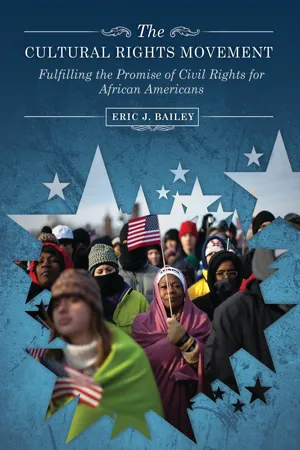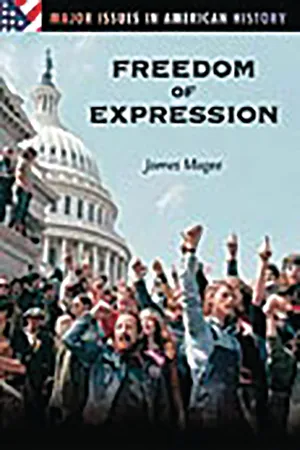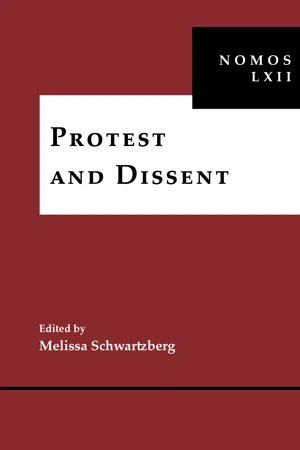History
Civil Rights Protests
Civil rights protests refer to organized demonstrations and actions aimed at achieving equal rights and ending discrimination against marginalized groups, particularly African Americans in the United States. These protests were pivotal in the struggle for civil rights and led to significant legislative and societal changes, such as the Civil Rights Act of 1964 and the Voting Rights Act of 1965.
Written by Perlego with AI-assistance
Related key terms
1 of 5
3 Key excerpts on "Civil Rights Protests"
- eBook - PDF
The Cultural Rights Movement
Fulfilling the Promise of Civil Rights for African Americans
- Eric J. Bailey(Author)
- 2010(Publication Date)
- Praeger(Publisher)
1 When these civil rights are not granted to a person or an entire group of people, then a civil rights movement can emerge. Such a movement serves to reclaim a groups’ civil rights and advocates new laws to restrict the effects of discrimination. Thus, civil rights and a civil rights movement are terms and actions that apply to every citizen of the United States. If you ask the average U.S. citizen about the civil rights movement in America, they often refer to the African American civil rights move- ment of the 1950s and 1960s. Yet civil rights movements in America actually began a long time ago. As early as the 17th century, blacks and whites, slaves in Virginia and Quakers in Pennsylvania, protested the barbarity of slavery. Nat Turner, Sojourner Truth, Frederick Doug- lass, William Lloyd Garrison, John Brown, and Harriet Tubman are but a few of those who started the resistance to slavery before the Civil War. After the Civil War, another battle mounted against slavery’s legacy—racism and segregation. For most Americans, however, the civil rights movement began on May 17, 1954, when the Supreme Court handed down the Brown v. Board of Education of Topeka decision outlawing segregation in public schools. The Court unlocked the door, but the pressure applied by thousands of men and women in the movement pushed the door open wide enough to allow Blacks to walk through it toward this country’s essential prize: freedom. 2 When I think about the terms civil rights and the civil rights move- ment particularly as it relates to African Americans, it makes me think about my years growing up in the small rural Midwestern towns of Springfield and Wilberforce, Ohio, during the late 1950s and 1960s with my parents and older brothers. Being born and living in Springfield until I was about seven years old, our family was quite similar to many other young African American families during this time period. - eBook - PDF
- James Magee(Author)
- 2002(Publication Date)
- Greenwood(Publisher)
Unlike national news anchors, however, civil rights leaders and disenfranchised blacks initially had no ready access to the national media. They sent their messages through "sit-ins," public protest and marches, demonstrations, and other forms of "symbolic" speech by which they hoped to push the degrading reality of segregation to the front of the national agenda. The traditional means of citizen protest, voting, was largely unavail- able to most blacks in the South, despite the Fifteenth Amendment. State- created tests and preconditions allowed only a very small percentage of blacks to register and vote in the South, and efforts to register and vote faced bureaucratic obstacles and violence. The strategy of leaders such as Martin Luther King, Jr., and his Southern Christian Leadership Con- ference (SCLC) called, instead, for nonviolent resistance and peaceful protest and civil disobedience of unjust laws. During freedom rides, sit- ins, and other protests, many blacks and their white supporters were brutally beaten; many were arrested and convicted; and some of their cases reached the U.S. Supreme Court. The Court was usually sympa- thetic to free speech rights in the civil rights cases and protected the speakers and protesters, finding various ways to shield this public form of protest from the criminal laws of the states. In 1955 Rosa Parks, a forty-three-year-old black seamstress and mem- The Civil Rights Movement 177 ber of the local chapter of the NAACP, in Montgomery, Alabama, re- fused to surrender a "white" seat and to move, instead, to the "colored" section of a public bus as required by local law. Many regard this sym- bolic act as the beginning of the civil rights movement—at least outside the courtrooms. - eBook - ePub
Protest and Dissent
NOMOS LXII
- Melissa Schwartzberg(Author)
- 2020(Publication Date)
- NYU Press(Publisher)
Social protest can be a reaction to an inadequate or corrupt political process or market economy—mass demonstrations for women’s suffrage are a paradigmatic example of such a protest, since it was a protest movement that aimed to correct the political process itself. But any protest that advances a cause that hasn’t gotten a fair shake in the political process qualifies. Protest can also be a reaction to a violation of fundamental rights—here the fairness of the political or market processes that brought about the challenged result are irrelevant because a violation of rights is never justified. Protest can also be an established part of a political system or market—such as labor picketing sanctioned under the National Labor Relations Act.Protest, then, can be a disruption of the political and economic status quo, or it can be an expected part of the day-to-day operation of the system—politics by other means. A proviso. When I criticize certain protests, I do not intend to imply a legal argument concerning the “rights” of individuals and groups to assemble and express themselves. Although some of my argument has implications for First Amendment doctrine, which I will explore in a brief conclusion, my central argument concerns the wisdom and civic-mindedness of protest—not its legality.Costs
There are costs to the overuse of protest.Inconvenience and Disruption
Most obviously, protests and mass demonstrations are time-consuming and inconvenient for nonparticipants: They block streets in congested cities, disrupting normal commuting and commerce. This may seem trivial as compared to the importance of a political cause, but inconvenience is not the only problem. Blocked streets can impede the movement of emergency vehicles, resulting in life-threatening delays. Large, unruly crowds are magnets for criminals, sociopaths, and disruptive elements—as a consequence, violence and destruction are always a risk, and police must be deployed at significant public expense.
Index pages curate the most relevant extracts from our library of academic textbooks. They’ve been created using an in-house natural language model (NLM), each adding context and meaning to key research topics.


